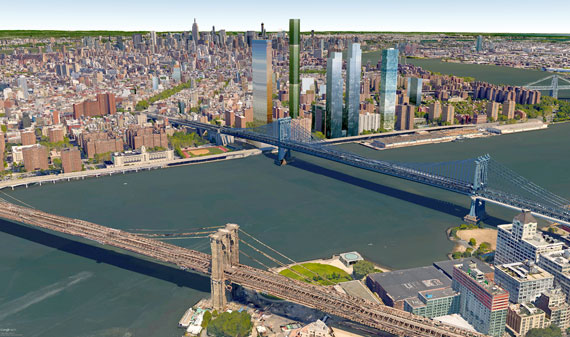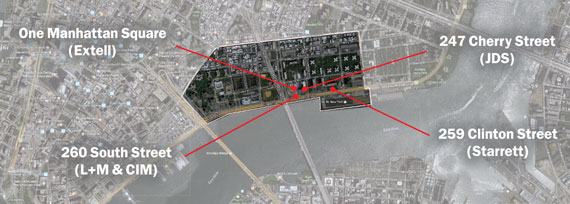Michael Stern was approaching the lectern when a booming voice from the back of the Gouverneur Health building at 227 Madison Street stopped him in his tracks. “Boo!” the young man shouted, directing his anger at the JDS Development Group [TRDataCustom] CEO and stunning the room into silence. “You greedy corporate fuck! Fuck JDS, you greedy corporate motherfucker!”
The guarded and low-spoken Stern stepped back as community members who showed up at the meeting to hear about three or four megaprojects coming to the Two Bridges neighborhood argued for nearly 10 minutes. On one side of the argument was a faction of attendees who wanted to hear the developers’ plans and how they would affect the neighborhood that sits between the Brooklyn Bridge and Manhattan Bridge. On the other side were those who felt the developers were indifferent to the community’s concerns and merely putting on a dog and pony show to inveigle public support.
The former bloc eventually won out, and for the next hour or so Stern and representatives from L+M Development Partners, CIM Group and Starrett Corporation discussed their upcoming projects, which will transform a neighborhood heavily composed of low-income and senior housing.
When Stern finally got a chance to speak, he laid out what he thought to be the big picture — the fact that all of the developers are setting aside 25 percent of their apartment units at below-market rents. “We’re building a lot of market-rate units, which I think is a big focus,” the 37-year-old developer said. “But this is also the single largest creation of affordable units in one shot in this district in a very long time.”
When Mayor Michael Bloomberg’s administration downzoned much of the Lower East Side in 2008, city planners stopped short at the boundary of the Two Bridges neighborhood, where land-use rights have largely remained frozen in time since the city passed the 1961 Zoning Resolution.
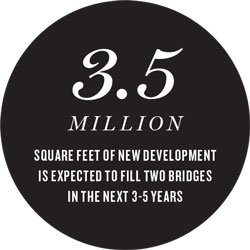 There, hidden in plain sight all those years, lies a four-block stretch along the East River with the same key elements that Gary Barnett’s Extell Development Company and Stern’s JDS, among others, used to transform West 57th Street into Billionaires’ Row.
There, hidden in plain sight all those years, lies a four-block stretch along the East River with the same key elements that Gary Barnett’s Extell Development Company and Stern’s JDS, among others, used to transform West 57th Street into Billionaires’ Row.
In the blink of an eye, it seems, Two Bridges is set to undergo a radical change, with the planned gleaming towers that will range from 700 feet to more than 1,000 feet tall and add some 3,700 new apartments to the neighborhood. Industry players who know the neighborhood, however, say the influx of development should come as no shock.
“I’m not surprised by these developments,” said Michael DeCheser, an investment sales broker at Cushman & Wakefield who covers the area. “If you were a developer looking to either build inclusionary or generate inclusionary credits, these are the only blocks you could focus on in the area.”
The four-block area that major developers are homing in on contains sites big enough to include an affordable-housing component — which generates building bonuses that allow the developers to construct larger properties. The area also has the necessary R10 zoning, which allows for the densest residential buildings in the city. “If you want to build affordable housing, you have to look for R10, and there’s a very limited amount of it in Manhattan,” DeCheser said.
But it hasn’t all been smooth sailing for the opportunistic builders, as local community groups have pushed to curb out-of-character development in Two Bridges. Back in 2013, the community planning initiative Chinatown Working Group and the Pratt Center for Community Development conducted a study that recommended rezoning the area with a height limit of 350 feet. And earlier this year, City Council member Margaret Chin, who represents the neighborhood, spearheaded a failed effort to force three of the planned towers to go through the city’s arduous Uniform Land Use Review Procedure.
City Planning Commission Chairman Carl Weisbrod determined a few months later, however, that the developers could build their towers as of right, which means no additional approvals from the city would be required.
“I understand it’s as of right, but that doesn’t mean it is right,” said Trever Holland, a member of several community groups in the neighborhood. “There’s absolutely no infrastructure to handle the Extell [project], let alone the other projects.”
Meanwhile, change in the neighborhood may not end along the waterfront.
There are several blocks farther inland where developers and investors can find additional opportunities to build. In November, for instance, the Midtown-based development firm Ascend Group paid $47.5 million to buy the former Bialystoker nursing home at the edge of the neighborhood at 228 East Broadway. The property came with an adjacent site at the corner of Clinton Street that holds about 40,000 square feet of development rights.
One of the difficulties with finding buildable sites in Two Bridges is the large number of city-owned properties in the neighborhood, according to data from Cushman. Out of the 30 blocks between the Brooklyn Bridge to the west and Montgomery Street to the east, 15 are owned by the city.
Still, in between East Broadway and Monroe Street lie several parking lots that could be turned into additional high-rises. At 40 Henry Street, for example, a handful of properties that run through the other side of the block to Madison Street hold nearly 72,000 square feet of development rights.
And New Jersey-based Edison Properties owns a mini-storage facility along the water at 220 South Street, west of the Manhattan Bridge. The site is currently zoned for manufacturing use, though one of the proposals set forth the by the Chinatown Working Group would upzone it for commercial or residential use, giving the property 670,000 buildable square feet as of right.
At the community meeting last month, Manhattan Borough President Gale Brewer said that neighbors would have a chance to discuss things like affordability levels in the new towers and how the projects would affect school enrollment, traffic and open space. The existence of the towers themselves, however, was a done deal, she noted.
“Would I like to have smaller buildings? Yes,” Brewer said. “But I’m not so sure that would be as possible, but almost everything else is on the table.”
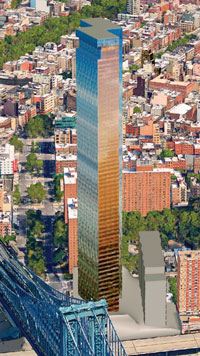
One Manhattan Square
One Manhattan Square (Extell)
One Manhattan Square — Barnett’s 815-unit condo project at 252 South Street — has risen about two dozen stories alongside the Manhattan Bridge. In December, the developer announced that a 3,699-square-foot duplex penthouse at the tower-to-be was in contract for roughly $13 million.
The 68-story property is scheduled for completion in late 2018 and will have some over-the-top amenities, including an “adult tree house.” The company is also developing 205 units of affordable housing next door, which generated building bonuses for the 850-foot-tall condo tower. But aside from facing community opposition, Barnett has also had to battle with market forces. The developer struggled to get financing for the condo tower before ultimately locking down a construction loan this year from RXR Realty. Barnett had to pay a price and give RXR a preferred equity stake in the project.
He also had to scale back his expectations, shaving more than $200 million off the projected sellout last February, to $1.8 billion. The developer launched sales in November, with prices ranging from the low $1 millions for a one-bedroom to as much as $4.35 million for a three-bedroom.
Barnett bought the development site, which formerly housed a Pathmark supermarket, in 2013 from Gary Spindler’s Park-It Management for $103.5 million and paid another $46.5 million to buy the supermarket out of its lease. Barnett declined to comment.
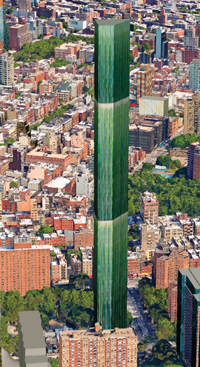
247 Cherry Street
247 Cherry Street (JDS)
Stern — who is developing the supertall 111 West 57th Street on Billionaires’ Row, near Barnett’s One57 — is following the Extell chief’s lead once again.
But JDS is not only facing opposition from community groups for the proposed 600-unit rental tower on Cherry Street. The firm is also dealing with pushback from a rival developer who claims Stern muscled him out of the development site, where Stern plans to build the tallest high-rise of the bunch at more than 1,000 feet. Park-It’s Spindler, who sold Extell the 252 South Street site, filed a lawsuit against JDS in August claiming he had a contract with the property’s owner to buy its air rights for $4 million.
Spindler has controlled a neighboring site at 235 Cherry Street since 1995 via a ground lease that runs through 2044. He claims that Stern interfered with the deal in order to co-opt his development and air rights so that JDS could “win the ‘prize’: to build the tallest skyscraper in Lower Manhattan.”
Spindler claims that as a tenant in the ground lease, his firm has the right to scuttle JDS’s planned 79-story tower, which would cantilever over his property and require the use of his site for construction.
“Stern is moving forward with this project as if it’s some sort of fait accompli,” said Raymond Hannigan, Spindler’s attorney at Herrick, Feinstein. “I think Stern’s own zoning advisers are aware that [Spindler] has veto power. I think that to the extent he’s moving forward, he’s deluding himself.” Stern declined to comment.
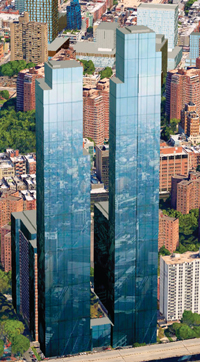
260 South Street
260 South Street (L+M & CIM)
One of the city’s largest affordable-housing developers teamed up with one of the city’s largest condo investors this cycle to build a 1 million-square-foot complex on the river.
The partners revealed their plans in December to build up to 1,350 apartments in two towers connected by a base, the tallest of which will stand at nearly 800 feet. As many as 335 of the units will be set aside for low- and middle-income families. The two companies teamed up in 2013 to buy Lands End II — a pair of Section 8 rental buildings on Cherry Street with 490 units — for $279 million from Starrett. The deal came with a parking lot that sits at the base of the existing buildings and faces the river. L+M plans to develop its new towers on that lot.
“We view this as an opportunity to provide meaningful improvements for our current residents and the broader neighborhood,” said David Dishy, a partner at L+M.
The setup does present at least one hurdle, though: The new towers will block the river views for about 100 apartments in the two Section 8 buildings, so as an olive branch to residents in those apartments, L+M is planning to upgrade the amenities at Lands End II.
Gary Handel, the architect on the project, said the developers had considered building a smaller, single building that would tower over the Lands End II courtyard, but decided instead to go with the two-tower design.
“That creates a taller building but allows light and air into that courtyard,” he explained.
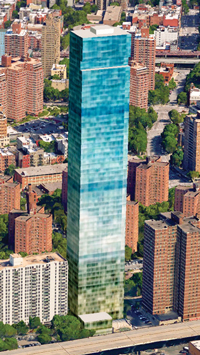
259 Clinton Street
259 Clinton Street (Starrett)
Filling in the last piece of the four-megaproject puzzle, Starrett plans to build a 62-story rental tower with 732 apartments at a development site at 259 Clinton Street, located between Pier 42 and Pier 35.
In 2015, the Midtown-based company sold the 258-unit, mixed-income Lands End I building at 257-271 South Street to L+M and Queens-based Nelson Management Group but kept the adjacent development site, where it now plans to build its 620,000-square-foot tower.
Starrett — which has played an active role in affordable-housing creation in the past — will set aside 183 units in the building at below-market rents, according to a preliminary proposal.
“We’re really trying to answer the mayor’s call for affordability,” Josh Siegel, one of the company’s executives in charge of development and acquisition, told residents at the community meeting. “That’s what this project is aimed at. We are trying to answer that call to increase affordable housing, which as we all know is always desperately needed in New York City.”
Perkins Eastman’s Michael Lew, the architect on the project, said the completed project will also include about 2,500 square feet of retail on South Street, adjacent to the elevated FDR Drive roadway.
“One thing that we’re looking at is trying to really activate the streetscape around there,” Lew said.
The developer plans to begin construction on the tower in 2018 with no completion date specified. Representatives for Starrett could not be reached for further comment.
